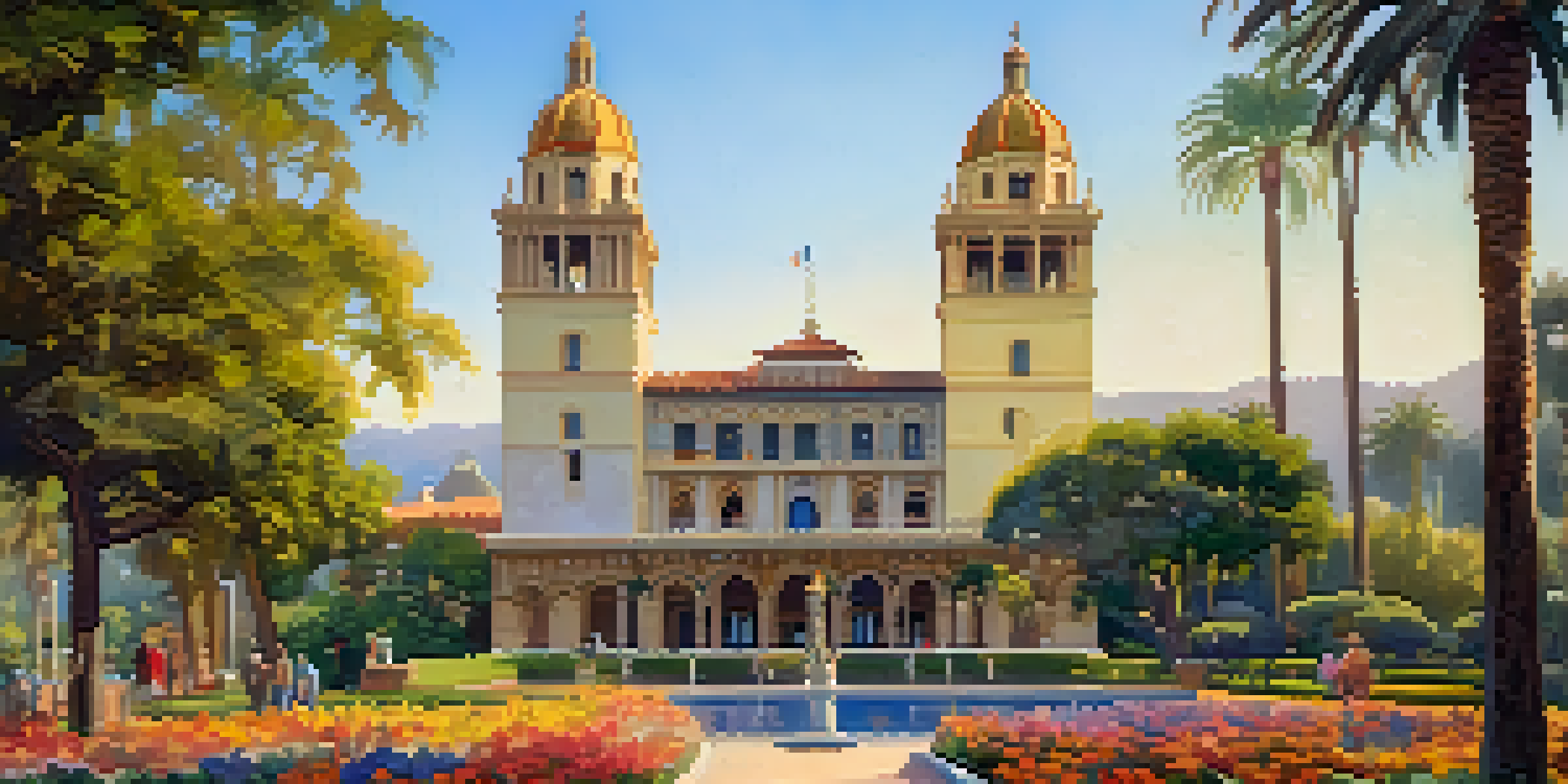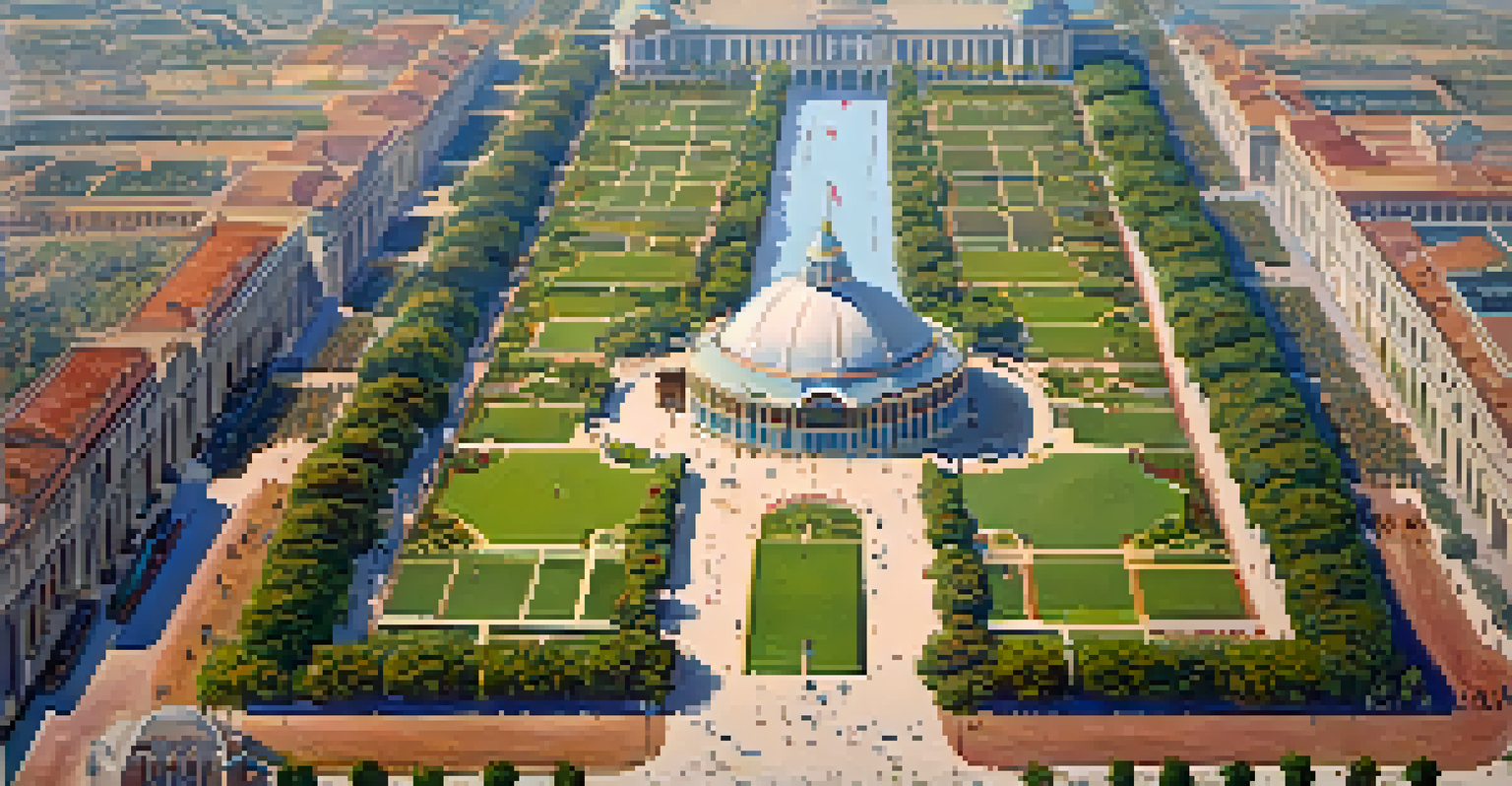The Impact of the 1915 Panama-California Exposition on Planning

The Historical Context of the 1915 Panama-California Exposition
The 1915 Panama-California Exposition was held in San Diego to celebrate the opening of the Panama Canal. This event not only showcased the canal's significance but also highlighted the city's cultural and architectural aspirations. With the backdrop of World War I brewing, the exposition served as a moment of hope and progress, drawing attention to San Diego's potential as a growing metropolis.
Architecture is the learned game, correct and magnificent, of forms assembled in the light.
The exposition featured stunning pavilions, gardens, and the iconic California Tower, which became symbols of the city’s identity. This grand event attracted over 3 million visitors, showcasing innovations in architecture and urban design at a time when cities were rapidly evolving. As people wandered through the fairgrounds, they experienced a vision of what modern urban living could be.
In many ways, the exposition was a catalyst for change, pushing San Diego into the spotlight. It encouraged city planners and architects to think creatively about how public spaces could serve the community. The excitement generated by the event laid the groundwork for future developments and planning initiatives.
Architectural Innovations Inspired by the Exposition
One of the most significant impacts of the exposition was its emphasis on architectural innovation. The fair introduced the Spanish Colonial Revival style, which became a defining characteristic in Southern California architecture. This aesthetic harmoniously blended with the region's natural beauty, influencing not only buildings but also the overall urban landscape.

The design of the exposition emphasized open spaces and accessibility, principles that urban planners would later adopt. The event encouraged the integration of parks, plazas, and gardens into city planning, fostering a sense of community and connection with nature. This shift was particularly crucial in an era where industrialization was rapidly transforming urban environments.
Exposition Sparked Urban Innovations
The 1915 Panama-California Exposition introduced architectural styles and urban planning principles that reshaped city landscapes.
As visitors marveled at the creative structures, they were also inspired to envision their own communities differently. The exposition became a blueprint for future architectural endeavors, demonstrating how thoughtful design could enhance the quality of life. The ideas birthed during this time still resonate in today's urban planning.
Influence on Urban Planning Practices
The Panama-California Exposition had a profound influence on urban planning practices that extended well beyond its immediate aftermath. City planners began to prioritize the importance of aesthetics in public spaces, focusing on how these environments could foster social interaction. This perspective was a shift from the more utilitarian approaches that had dominated urban planning previously.
The greatest cities are not those that are built, but those that are built upon the hearts of their people.
Moreover, the emphasis on integrating nature into urban environments became a guiding principle. The exposition's gardens and open areas demonstrated the value of green spaces, prompting cities to consider parks and recreational areas in their planning efforts. This focus on quality of life and environmental considerations would later evolve into the modern urban planning concepts we see today.
Cities across the United States looked to San Diego as a model for their own developments. The principles established during the exposition paved the way for planned communities and urban designs that prioritize both functionality and beauty. This legacy continues to influence how cities are developed and planned.
Cultural Significance and Community Identity
The 1915 exposition was not just an architectural showcase; it also played a critical role in shaping San Diego's cultural identity. It highlighted the city’s diverse heritage, celebrating not only American culture but also the influences of Spanish and Mexican traditions. This rich cultural tapestry became an integral part of the city's identity, fostering pride among its residents.
The infusion of culture into urban planning led to the creation of spaces that reflected the community's values and history. As new neighborhoods were developed, planners took cues from the exposition, incorporating cultural elements into public art, festivals, and community spaces. This approach helped strengthen community ties and foster a sense of belonging.
Cultural Identity and Community Pride
The event celebrated diverse cultural influences, fostering a sense of pride and identity among San Diego residents.
In this way, the exposition's legacy can be seen in the vibrant cultural landscape of San Diego today. The event inspired ongoing celebrations of diversity, influencing how the city embraces its multicultural heritage. The impact of the exposition continues to resonate, shaping how communities come together and celebrate their identities.
Environmental Considerations in Urban Design
The Panama-California Exposition highlighted the importance of environmental considerations in urban design. With its emphasis on gardens and natural landscapes, the fair demonstrated how cities could integrate nature into their planning. This was a revolutionary idea at the time and has since become a cornerstone of modern urban planning.
Planners took note of how the exposition's layout encouraged people to connect with their surroundings. The integration of parks and open spaces into the city’s fabric became a priority, recognizing the need for areas where residents could relax and enjoy nature. This focus on the environment continues to be influential, shaping policies and designs that prioritize sustainability.
Today, urban planners strive to create spaces that not only serve the needs of the community but also respect and enhance the natural environment. The legacy of the 1915 exposition is evident in contemporary initiatives that promote green spaces, eco-friendly architecture, and sustainable urban practices. This commitment to environmental stewardship is a vital aspect of modern city planning.
Legacy of the Exposition in Modern Urban Development
The legacy of the Panama-California Exposition can be seen in many aspects of modern urban development. Its influence is evident in the way cities prioritize aesthetic appeal alongside functionality. Urban planners now often incorporate historical elements and cultural significance into their designs, much like the exposition did over a century ago.
Moreover, the principles of community engagement and public participation that emerged from the exposition are now foundational in urban planning. The idea that communities should have a say in the development of their spaces has transformed the planning process. As a result, cities today are more responsive to the needs of their residents, creating environments that truly reflect their desires.
Environmental Focus in Urban Design
The exposition highlighted the importance of integrating nature into urban planning, a principle that remains vital in modern development.
This shift towards inclusivity and aesthetic consideration in planning can be traced back to the ideas fostered during the 1915 exposition. As cities evolve, the lessons learned from this landmark event continue to guide urban development, ensuring that the future remains vibrant and interconnected with the past.
Conclusion: Reflecting on the Exposition's Impact
In conclusion, the 1915 Panama-California Exposition ignited a wave of change that significantly impacted urban planning and design. From architectural innovations to cultural representations, it reshaped how communities viewed their environments. This event not only celebrated progress but also laid the groundwork for future developments that prioritized aesthetics and community engagement.
As we reflect on the legacy of the exposition, it becomes clear that its influence is still felt today. The principles of thoughtful design, environmental stewardship, and cultural integration remain central to modern urban planning. The exposition serves as a reminder of the power of vision and creativity in shaping our communities.

Ultimately, the Panama-California Exposition was more than just a fair; it was a transformative event that helped define the future of urban development. Its impact continues to inspire planners, architects, and communities as they work to create spaces that enhance quality of life and reflect shared values.